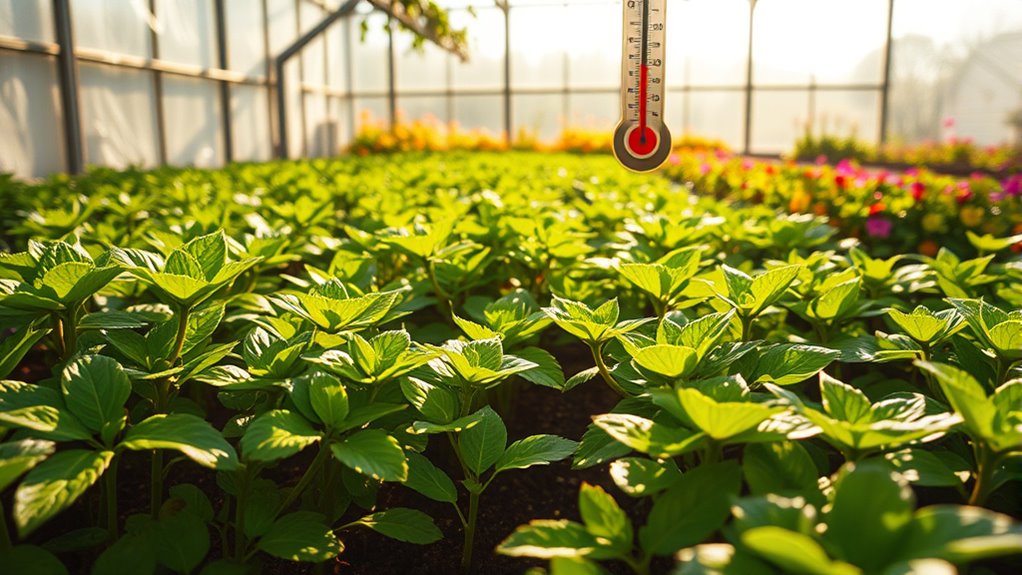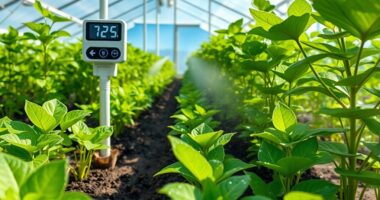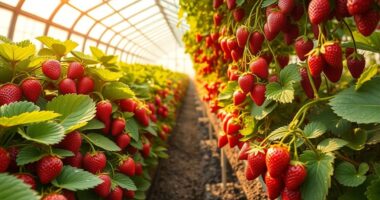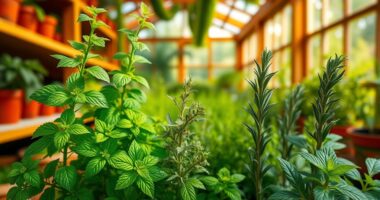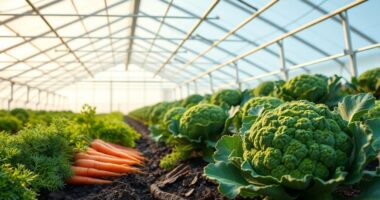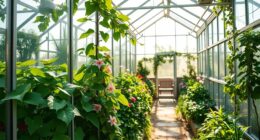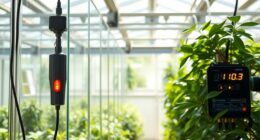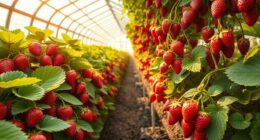For greenhouse plants, light requirements vary by species and growth stage. Most plants thrive with at least 10,000-20,000 lux, while high-light crops like tomatoes may need up to 40,000 lux. Using a mix of natural sunlight and efficient LEDs can optimize growth. Factors like plant spacing, reflective surfaces, and proper greenhouse design enhance light distribution. Understanding these needs can improve yields significantly. Discover how to effectively manage light for your plants as you explore further.
Key Takeaways
- Most greenhouse plants thrive with a minimum light intensity of 10,000 to 20,000 lux, with high-light species requiring up to 40,000 lux.
- Light needs vary by plant species and growth stages, with blue light essential for vegetative growth and red light supporting flowering.
- Seasonal fluctuations and geographic location impact natural light availability, necessitating adjustments in supplemental lighting strategies.
- Using reflective surfaces and light movers can optimize light distribution, ensuring all plants receive adequate exposure.
- Customizing light spectra with LEDs can enhance nutrient absorption and potentially increase yields by up to 20%.
Types of Light for Greenhouse Plants
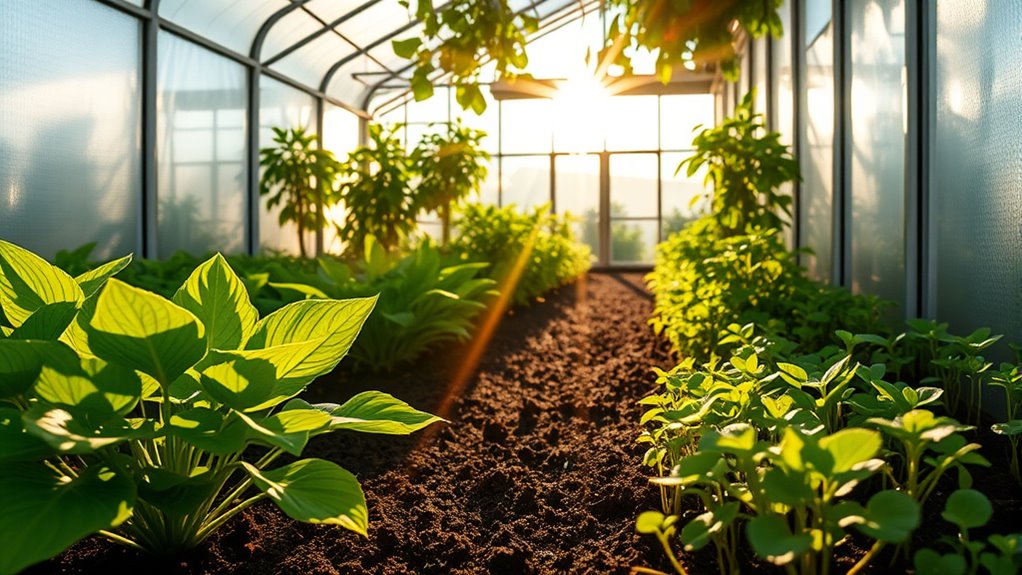
When growing plants in a greenhouse, understanding the types of light available is crucial for their health and productivity.
Natural sunlight provides a full spectrum essential for your plants’ growth and blooming, but keep in mind that its availability fluctuates with the seasons and your location.
Greenhouses trap sunlight, creating a warm environment, but you may need to manage temperature through ventilation.
On the other hand, artificial lighting options like fluorescent and LED lights can supplement natural light.
LEDs are particularly energy-efficient and customizable, helping support different growth stages.
Each light type serves unique purposes, so consider your plants’ specific needs to optimize growth and ensure a thriving greenhouse.
Understanding Light Intensity Requirements
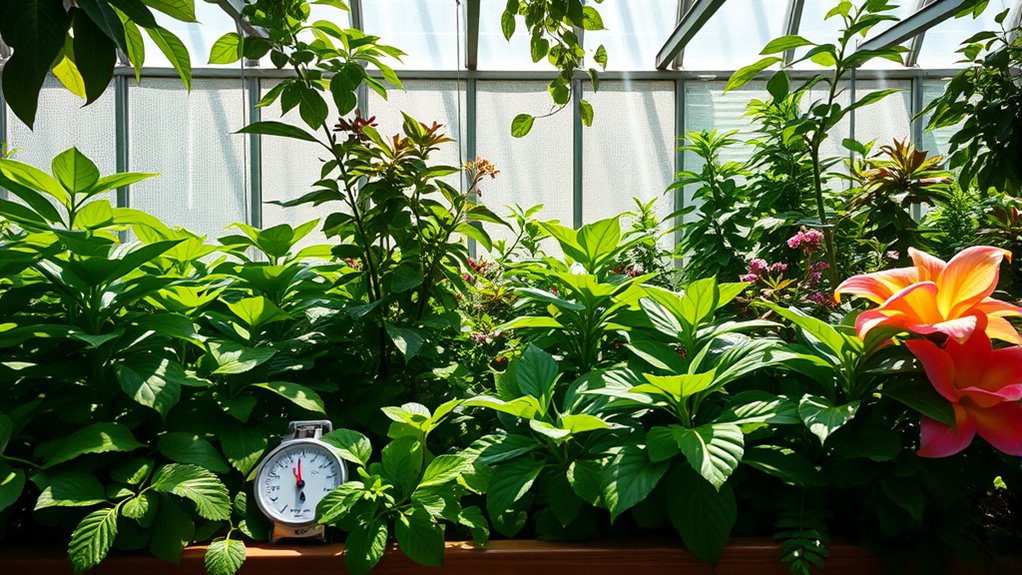
Understanding light intensity requirements is vital for maximizing plant health and productivity in your greenhouse.
Light intensity can range from 3,000 lux on dreary winter days to 130,000 lux during bright summer days. Most plants thrive with a minimum of 10,000 to 20,000 lux, while high-light species like tomatoes may need up to 40,000 lux.
Many crops reach light saturation at around 32,000 lux for their upper leaves. Keep in mind that different growth stages and species have unique light needs, influencing photosynthesis and growth rates.
To ensure optimal conditions, consider using light meters to measure intensity and adjusting your setup with shading techniques or supplemental lighting when necessary.
Factors Influencing Light Needs
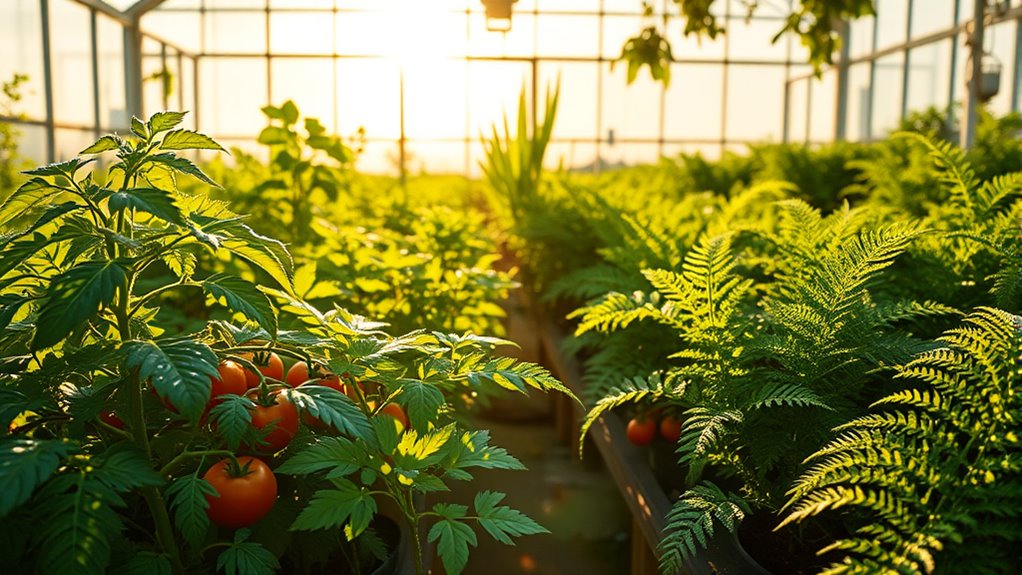
Several factors influence the light needs of greenhouse plants, and recognizing these can enhance growth and productivity.
Different plant species have specific light requirements that change during their growth stages; for example, blue light is crucial during vegetative growth, while red light supports flowering.
Additionally, photoperiodism plays a role—long-day, short-day, and neutral plants respond differently to light duration, impacting their growth and flowering.
The greenhouse structure also matters; its shape and glazing materials affect natural light transmission.
Climate and location further influence light availability, with seasonal variations and cloud cover necessitating adjustments in your lighting strategy.
Tailoring light quality and spectrum can optimize conditions, ultimately enhancing crop yield and quality.
Strategies for Optimizing Light Distribution
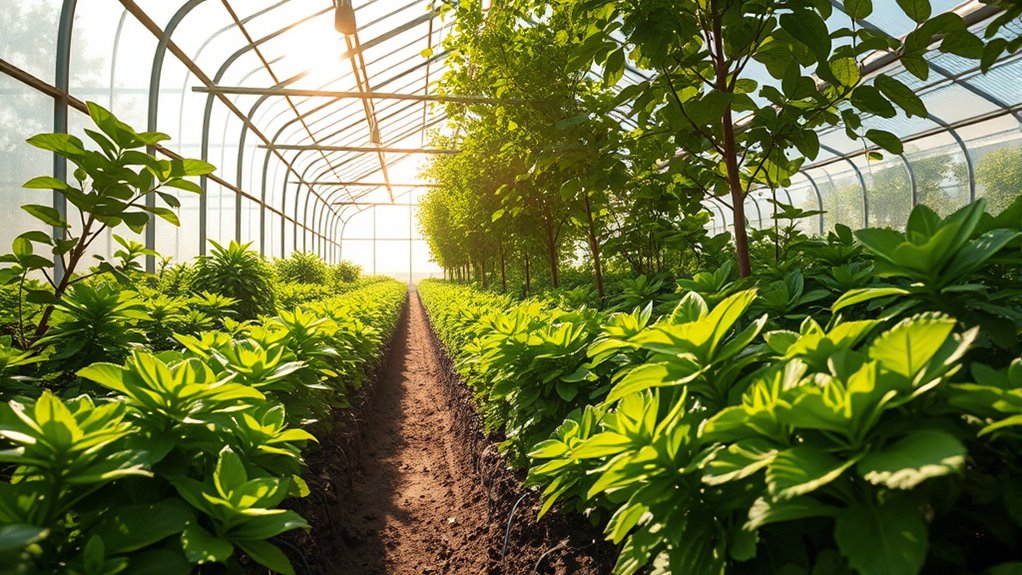
To optimize light distribution in your greenhouse, employing effective strategies is essential for maximizing plant growth and health.
Start by using reflective surfaces like Mylar or white paint on walls and ceilings to bounce light back onto your plants. Consider installing light movers to ensure even light distribution, avoiding shadows and overexposure.
Proper spacing is crucial; place taller plants at the back and shorter ones at the front for optimal light access. Implement light diffusion techniques to reduce harsh sunlight and promote balanced growth.
Lastly, divide your greenhouse into grow zones tailored to specific crop needs, allowing for customized lighting strategies that enhance efficiency and effectiveness, ensuring each plant thrives under the best conditions.
Benefits of Optimized Lighting
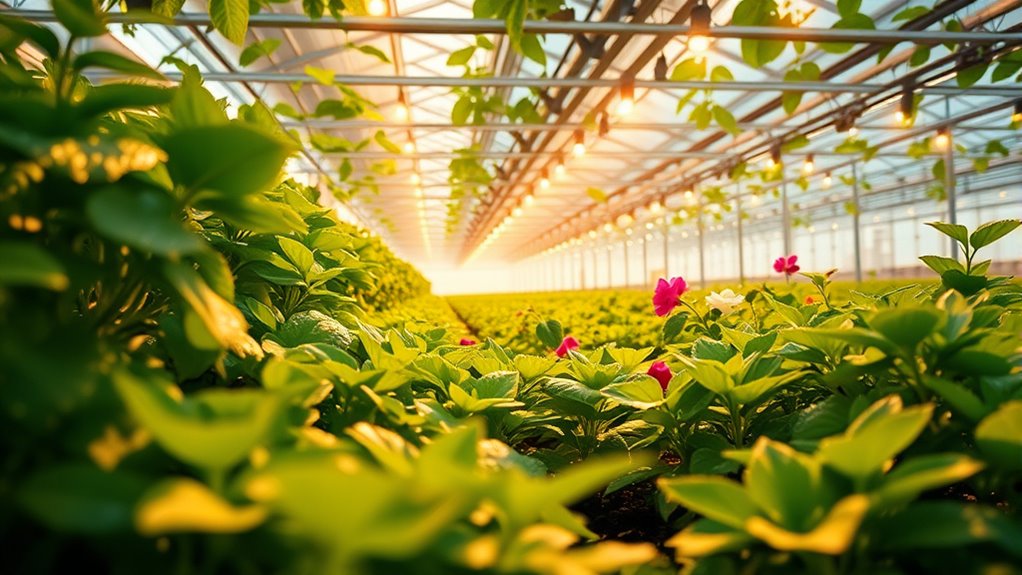
Optimizing light distribution in your greenhouse brings numerous benefits that can significantly impact plant growth and health.
With optimized lighting, you can boost photosynthesis by up to 15%, enhancing the overall health of your plants. Customizable light spectra from LEDs improve nutrient absorption, leading to faster growth rates—up to 30% for leafy greens—and increased yields, like 20% more tomatoes.
Energy efficiency is another key advantage; LEDs consume up to 50% less energy than traditional systems, saving you on costs. Additionally, optimized lighting supports year-round production, ensuring consistency and reducing seasonal risks.
Choosing the Right Lighting Fixtures
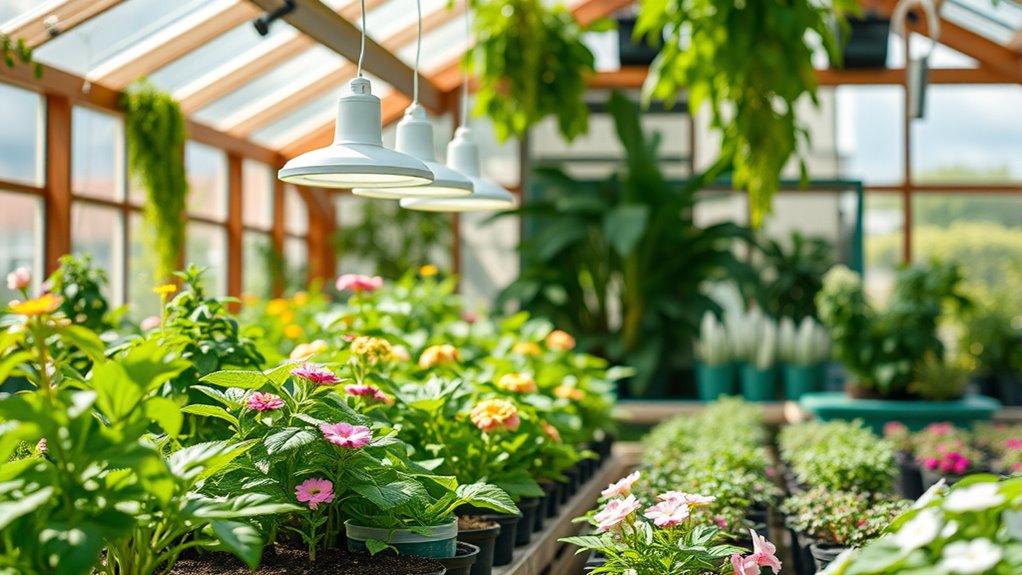
Choosing the right lighting fixtures for your greenhouse is crucial for maximizing plant growth and health.
Start by considering the light spectrum; full-spectrum lights mimic natural sunlight, which many plants thrive on. For energy efficiency, LEDs are a top choice, offering up to 70% savings and lasting around 50,000 hours.
Consider full-spectrum lights for optimal plant growth, and choose energy-efficient LEDs for long-lasting savings.
If you’re focusing on flowering plants, high-pressure sodium fixtures can be beneficial due to their red/orange spectrum. For vegetative growth, metal halide lamps provide the necessary blue light.
Don’t forget about installation and safety—choose fixtures with appropriate IP ratings for water resistance.
Lastly, think about your budget; LEDs may cost more upfront but save you money in the long run.
Seasonal Considerations for Light Management

Managing light in your greenhouse throughout the year is essential for healthy plant growth. In winter, natural light often falls short, so you’ll need supplemental lighting to ensure your plants receive enough energy for photosynthesis.
Cloudy days can further limit light availability, especially in overcast regions, impacting plant development. During warmer months, excess sunlight can cause overheating, making shading or cooling systems necessary.
Seasonal changes in day length influence flowering and growth patterns, so you can use artificial lighting to manipulate photoperiods for optimal results.
Integrating Natural and Artificial Light

While natural sunlight is vital for plant growth in greenhouses, integrating artificial lighting can enhance productivity and ensure plants thrive throughout the year.
By utilizing supplemental grow lights like LEDs or high-pressure sodium lights, you can provide the specific light intensity and photoperiod your plants need. Different species have unique light requirements, so understanding their Daily Light Integral (DLI) is crucial.
Supplemental grow lights offer tailored light intensity and photoperiods essential for diverse plant species, emphasizing the importance of understanding their Daily Light Integral (DLI).
You can optimize light use by employing reflective surfaces or light movers for even distribution. Additionally, consider proper plant spacing to maximize exposure.
With effective light management, you’ll not only boost growth but also improve your greenhouse’s economic efficiency, making the investment in lighting systems worthwhile.
This balanced approach to light will pay off in healthier, more productive plants.
Frequently Asked Questions
How Do Different Plant Species Affect Light Requirements?
Different plant species have unique light requirements that directly influence their growth.
If you’re growing high light plants like orchids, you’ll need to provide ample light for optimal health.
Conversely, low light plants such as ferns thrive in shaded areas.
Understanding each species’ needs helps you tailor your lighting conditions, ensuring they receive the right intensity and duration to flourish.
Adjusting your setup based on these factors can lead to thriving plants.
Can I Use Household Light Bulbs for Growing Plants?
Imagine trying to bake a cake in a toaster—it might work, but it won’t be great.
You can use household light bulbs for growing plants, especially leafy greens, but they aren’t ideal. Their spectrum and photon density fall short for optimal growth.
If you’re starting seeds or growing small plants, they’re budget-friendly. Just remember, for flowering or fruiting plants, dedicated grow lights will really give you the results you want.
What Are the Signs of Inadequate Lighting in Plants?
When your plants don’t get enough light, you’ll notice several signs.
They might grow leggy and weak, stretching towards the nearest light source. Leaves can turn yellow or drop off as they struggle to photosynthesize.
You may also see smaller leaves and slower growth overall.
If you observe these changes, it’s a clear indication that your plants need more light to thrive and maintain their health.
How Does Light Quality Differ From Light Intensity?
Light quality and light intensity are distinct yet interconnected.
Light quality refers to the spectrum of light your plants receive, impacting their growth and photosynthesis, while light intensity measures how much light is available.
You need both to support healthy plant development. If you focus solely on one, you mightn’t achieve optimal growth, as each element plays a crucial role in how effectively your plants photosynthesize and thrive in their environment.
Are There Specific Light Requirements for Seedlings?
Imagine you’re a gardener, nurturing tiny seeds as if they were fledgling birds ready to take flight.
To help them soar, you need to provide specific light requirements. Seedlings thrive under full-spectrum light, ideally 14-16 hours a day, with intensity around 25,000 to 35,000 lux.
Keep your lights close, adjust as they grow, and remember, they need a rest period too.
With the right care, you’ll watch them flourish into robust plants.
Conclusion
In the vibrant world of greenhouse gardening, light is your plants’ lifeblood, a golden thread weaving their growth story. By understanding their unique light needs and cleverly mixing natural and artificial sources, you can create a thriving oasis that flourishes year-round. Remember, it’s not just about filling their space with brightness; it’s about crafting an environment where each leaf unfurls in gratitude. Embrace the dance of light, and watch your greenhouse bloom into a masterpiece of nature.
